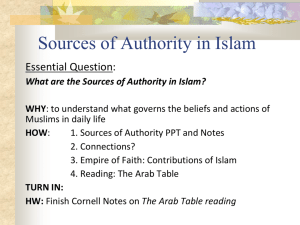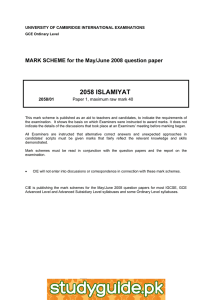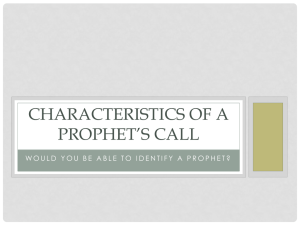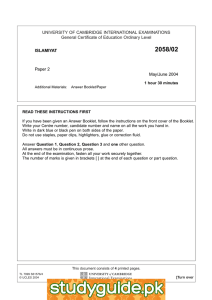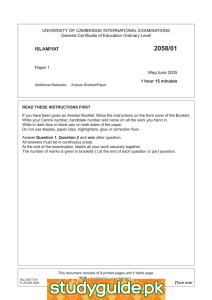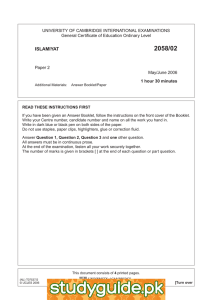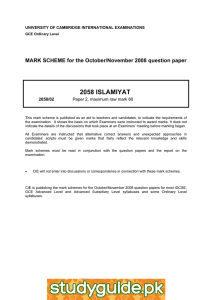2058 ISLAMIYAT MARK SCHEME for the October/November 2009 question paper
advertisement
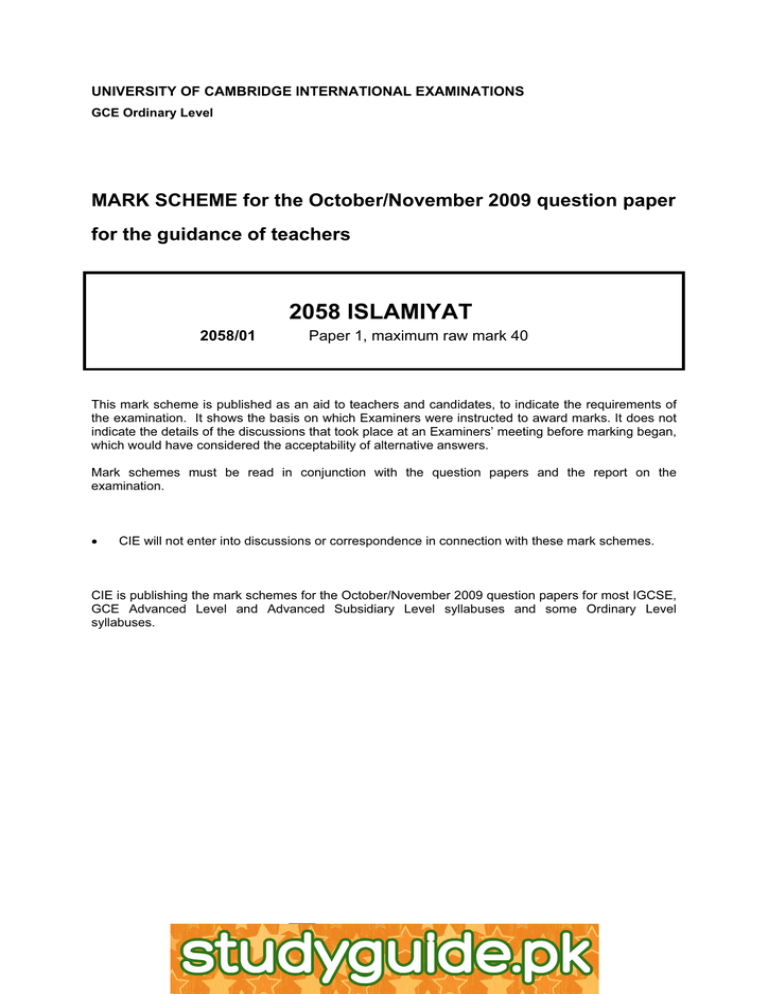
UNIVERSITY OF CAMBRIDGE INTERNATIONAL EXAMINATIONS GCE Ordinary Level MARK SCHEME for the October/November 2009 question paper for the guidance of teachers 2058 ISLAMIYAT 2058/01 Paper 1, maximum raw mark 40 This mark scheme is published as an aid to teachers and candidates, to indicate the requirements of the examination. It shows the basis on which Examiners were instructed to award marks. It does not indicate the details of the discussions that took place at an Examiners’ meeting before marking began, which would have considered the acceptability of alternative answers. Mark schemes must be read in conjunction with the question papers and the report on the examination. • CIE will not enter into discussions or correspondence in connection with these mark schemes. CIE is publishing the mark schemes for the October/November 2009 question papers for most IGCSE, GCE Advanced Level and Advanced Subsidiary Level syllabuses and some Ordinary Level syllabuses. www.xtremepapers.net Page 2 Mark Scheme: Teachers’ version GCE O LEVEL – October/November 2009 Syllabus 2058 Paper 01 AO1 (Knowledge – part (a) questions) Question 1(a) has a maximum mark of 4 and questions 2–5 have a maximum mark of 10. Level 4 3 2 Mark Question 1 4 3 2 Mark Question 2 Level Descriptor 8–10 Very Good/Excellent. A thorough, well-developed and substantial response. Demonstrates extensive, relevant and highly accurate knowledge of the subject in considerable detail and with evident expertise. Likely to quote Qur’an verses and Hadiths to support and illustrate points made. Comprehensive and thoughtful. 5–7 Good. Addresses the question confidently and coherently. Demonstrates sound, detailed and generally relevant and accurate knowledge of the subject matter in great detail. Covers the main points. May quote Qur’an verses and Hadiths to support points made. 3–4 Satisfactory. A fair, mainly relevant but generally undeveloped response. The candidate demonstrates some factual knowledge, which is fairly accurate and slightly wider than at basic level. Some of the main points are covered but lack substance. 1 1 1–2 Basic. An attempt to answer the question, but lacks potential and/or is unfinished. Very limited knowledge of the subject. Response includes only a small amount of relevant material, or mainly irrelevant points. Facts are reported in basic outline only, often inaccurately, though some credible points are made. 0 0 0 Irrelevant. No apparent attempt to answer the question set, or a wholly irrelevant response. Totally illegible. AO2 (Understanding – part (b) questions) Level Mark Level Descriptor 4 4 Very Good/Excellent. Demonstrates a wide and thorough understanding of what the question asks. Recognises fully and can explain the significance of material used in answer. Can reason, evaluate and discuss in a thoughtful, mature manner. 3 3 Good. Understands the significance of the question. Seeks to move clearly beyond a purely descriptive approach, demonstrating touches of maturity and a willingness to engage with and discuss the material. 2 2 Satisfactory. Response is descriptive but makes some effort to offer evaluation. The candidate attempts, though with limited success, to move beyond a purely factual approach, with some limited discussion of the material. 1 1 Basic. Limited understanding of the subject. The candidate’s response is descriptive and immature, with no attempt to discuss or evaluate the material. 0 0 Irrelevant. No response submitted, or clearly lacks any understanding of the subject matter. © UCLES 2009 www.xtremepapers.net Page 3 Mark Scheme: Teachers’ version GCE O LEVEL – October/November 2009 Syllabus 2058 Paper 01 Candidates must attempt Question 1, Question 2 and two other Questions. 1 Choose any two of the following passages from the Qur’an, and: (a) briefly describe the main theme(s) in each passage; [4] (b) briefly explain how each passage presents its theme(s) in a distinctive way. [4] In order to give a mark for AO1 you will have to read both part (a) answers, and similarly in order to give a mark for AO2 you will have to read both part (b) answers. You should give only two marks, one for both part (a) answers, and one for both part (b) answers. When marking this question, you may have to read the answers a number of times. (i) Sura 2.30-37 30. Behold, your Lord said to the angels: ‘I will create a vicegerent on earth.’ They said: ‘Will You place there one who will make mischief there and shed blood?- whilst we celebrate your praises and glorify your holy (name)?’ He said: ‘I know what you do not know.’ 31. And He taught Adam the names of all things; then He placed them before the angels, and said: ‘Tell me the names of these if you are right.’ 32. They said: ‘Glory to You, of knowledge we have none, save what You have taught us: In truth it is You who are perfect in knowledge and wisdom.’ 33. He said: ‘Adam! Tell them their names.’ When he had told them, Allah said: ‘Did I not tell you that I know the secrets of heaven and earth, and I know what you reveal and what you conceal?’ 34. And behold, We said to the angels: ‘Bow down to Adam’. And they bowed down. Not so Iblis: he refused and was haughty: he was of those who reject faith. 35. We said: ‘Adam! You and your wife dwell in the Garden; and eat of the bountiful things in it as You wish. But do not approach this tree, or you will run into harm and transgression.’ 36. Then Satan made them slip from there, and got them out of what they had been in. We said: ‘Go down, with enmity between yourselves. On earth will be your dwelling-place and your means of livelihood, for a time.’ 37. Then Adam learnt from his Lord words of inspiration, and his Lord turned towards him; for He is often-returning, most merciful. (ii) Sura 5.110 Then will Allah say: ‘Jesus son of Mary! Recount my favour to you and to your mother. Behold! I strengthened you with the holy spirit, so that you spoke to the people in childhood and in maturity. Behold! I taught you the Book and Wisdom, the Law and the Gospel. And behold! You make out of clay, as it were, the figure of a bird, by my leave, and you breathe into it and it becomes a bird by my leave, and you heal those born blind, and the lepers, by my leave. And behold! You bring forth the dead by my leave. And behold! I restrained the Children of Israel from you when you showed them the clear signs, and the unbelievers among them said: 'This is nothing but evident magic.' (iii) Sura 108 1. To you have We granted abundance. 2. So pray to your Lord and sacrifice. 3. For he who hates you, he will be cut off. © UCLES 2009 www.xtremepapers.net Page 4 Mark Scheme: Teachers’ version GCE O LEVEL – October/November 2009 Syllabus 2058 Paper 01 (a) What are the main teachings? (i) Sura 2.30-37 Good answers for this passage will be able to talk about God as Creator and his relationship to his prophets. Answers may talk about God creating Adam, as well as everything else (angels, etc.), and the high position he granted him. They could also mention that God gives knowledge to who he wants and he gives the special status of prophethood to who he wishes. Also, even when Satan misled Adam, God did not leave him or allow any obstacle to prevent him from making Adam his representative on earth. (ii) Sura 5.110 Good answers of this passage will be able to talk about God and his power, and his relationship with Jesus. Answers may talk about the miracles God gave to Jesus as a sign of His power, and to protect his prophet. God showed his support for Jesus in many ways as a demonstration that Jesus was his prophet. (iii) Sura 108 Good answers for this passage will talk about God’s mercy/generosity and his relationship with the prophet Muhammad. Answers may talk about how God has granted the prophet success, and because of this his servants (the prophets) should continue to show loyalty to God even in times of difficulty. God remains near to his prophets. They can also talk about how God has promised to protect them, just as He protected the prophet from his enemies. (b) What do these teachings mean? (i) Sura 2.30-37 Answers could talk about how Adam was the first prophet of God, who was made his representative on earth. They could also mention how God showed Adam’s importance; by making the angels bow to him, and forgiving him when he disobeyed. Adam was chosen by God as his prophet and representative, and God maintained the relationship despite obstacles which shows an understanding of how God’s will always triumphs. (ii) Sura 5.110 Answers could give an insight into the relationship between God and his prophet, and the ways in which Jesus’ prophethood was shown. The creation of a bird from clay and raising the dead were clear signs that God had chosen Jesus. God supported him by giving him distinctive miracles and protected him from his opponents. (iii) Sura 108 Answers could give an insight into the relationship between God and the prophet. Good answers will suggest how God gave a promise to the prophet in times of difficulty. He gave the Prophet numerous followers but his enemies left no name on future generations. For his steadfastness he has been given future generations as well as blessings in the afterlife. God always intervenes in times of difficulty to ensure the welfare of His prophets. © UCLES 2009 www.xtremepapers.net Page 5 2 Mark Scheme: Teachers’ version GCE O LEVEL – October/November 2009 Syllabus 2058 Paper 01 (a) Write an account of the ways in which the Qur’an was revealed to the Prophet between the years 610 and 632. [10] This part of the answer requires a descriptive account of the revelations, from the first one to the last ones. Answers should indicate (and describe) that revelations came in both Makka and Madina. An account of the first experience should be given; when the prophet was meditating in Cave Hira, the Angel Gabriel came to him and commanded him to read. They could also add references to other revelations coming at other times without warning, that they induced bodily changes in the prophet, that they provided answers to situations happening in his life at that time. Examples and details should be given. Excellent answers will be able to provide a confident narrative of the modes in which revelation came down and give a coherent account of the history of the prophet’s experiences. (b) What does the Prophet’s first experience of revelation tell us about the nature of prophethood in Islam? [4] Candidates should try to give some insight into the revelations and their significance, rather than providing another descriptive account. Good answers could talk about the prophet’s surprise and confusion. They could also explain how the unannounced experience shows that God chose prophets, often without warning, and caused miraculous events at the time of calling. They could also draw parallels between the specific experiences of the prophet Muhammad and other prophets, and make general observations on the basis of these. 3 (a) Describe two events from the life of the Prophet that illustrate the way he treated nonMuslims. [10] Candidates can choose any two events and give a full and concise description of them. The point of the events should be underlined, as well as giving some reasons for the prophet’s conduct. Some events which candidates could talk about (though not the only ones) are: • his treatment of non-Muslims during the early persecution of Muslims in Makka; how he was taunted and had things thrown at him, and how he reacted • the story of the prophet going to Al-Ta’if; how they reacted to his message and how the prophet reacted to them • the conquest of Makka; his treatment of his non-Muslim enemies • his relationship with non-Muslims when they migrated to Madina; how he made treaties with the Jewish tribes and his interaction with them. There may be other relevant events that the candidates choose, which should be credited if they give a detailed description of them. (b) How can these examples help Muslims today in their relationships with non-Muslims? [4] Candidates should show some reflection on the two situations they have described in part (a) and relate them to their own personal relationships with non-Muslims, or the relationship of Muslims in general with non-Muslims. They could talk about the moral significance of the prophet’s actions and this should be used to highlight Muslim conduct today. A clear parallel should be drawn between the Prophet’s example and situations today, and specific examples given. © UCLES 2009 www.xtremepapers.net Page 6 4 Mark Scheme: Teachers’ version GCE O LEVEL – October/November 2009 Syllabus 2058 Paper 01 (a) Write briefly about the conversion to Islam of Abu Bakr, ‘Umar, ‘Uthman and ‘Ali. [10] Good answers for this part will give full, yet concise, accounts of the four conversion stories. Candidates should talk about the conversion stories and not their later lives. Some points that could be mentioned for each companion are: Abu Bakr: close friend of the prophet from childhood and amongst the first to convert (first free adult male); he became Muslim without hesitation; was open about calling others to the new faith and persuaded many to accept Islam; he purchased slaves and set them free; he was the first person to openly invite people to the new faith and was beaten severely. ‘Umar: he was initially angry at the prophet and the new message he was preaching and set out to kill him; on his way he was told his own sister and brother-in-law had converted and so went there; overheard recitation of part of sura Ta Ha; when he read the words himself he went to accept Islam; he had a reputation of being the fiercest man in Makka and so his conversion provided Muslims some protection; he fought Qur’aysh until Muslims could pray at the Ka’ba. ‘Uthman: he converted at the hands of Abu Bakr; was the third male convert; his family deserted him after his conversion; he was married to the Prophet’s daughter Ruqayyah soon after; amongst the first group to migrate to Abyssinia. ‘Ali: he was a cousin of the prophet who had been taken into the prophet’s household to alleviate the financial burden on his family; one of the first Muslims (only ten when he accepted Islam); when the prophet openly invited others to come to Islam, only ‘Ali stepped forward to help him; for this ‘Ali was made the prophet’s brother and vice-regent; caused ridicule amongst Qur’aysh who laughed at the thought of elders obeying ‘Ali; ‘Ali stood firm during persecutions. (b) In what ways did the conversion of ‘Umar help the young Muslim community? [4] Good answers here should show an understanding of the significance of ‘Umar’s conversion. Answers could talk about how his conversion boosted Muslim morale. He was an open persecutor and oppressor of Muslims, but upon conversion was the most open about public praying. Muslims couldn’t pray at the Ka’ba until he became Muslim. He helped the Muslims gain confidence in practising Islam openly; no-one dared interfere with ‘Umar when he was praying. He was known for his temper and his physical strength. All this gave a physical protection to the vulnerable Muslims. 5 (a) Trace the events that led up to the Prophet’s migration (hijra). [10] For this answer an account should be given about the events before the prophet migrated to Madina, not the actual journey or events of migration itself. Answers could briefly discuss the persecution of the Muslims by the Makkans and their migration to Abyssinia which later encouraged them to make the migration to Yathrib. The boycott of the Banu Hashim clan by the Qur’aysh followed by the deaths of Abu Talib and Hazrat Khadije are points that candidates can discuss when answering this question. Answers could also talk about the prophet’s reaction to the loss of protection and his attempts to spread Islam elsewhere. The prophet met six men in Makka, who had come from Yathrib for the annual pilgrimage. They became Muslim and returned to Makka the following year with more people who took an oath at ‘Aqaba in 621. The following year more people came to take the oath with the prophet. They invited the prophet to come to Yathrib as their leader. The best answers will be able to give details of the number of pledges, the number of Yathribites/Madinans involved, some brief details of what was in the pledges, and an indication of the result of the pledges. © UCLES 2009 www.xtremepapers.net Page 7 Mark Scheme: Teachers’ version GCE O LEVEL – October/November 2009 Syllabus 2058 Paper 01 (b) Explain the importance of the Pledges of ‘Aqaba to the Prophet in the period leading up to the migration. [4] Good answers should be able to talk about the prophet’s vulnerability at this time, and his attempt to gain support from other places (e.g. in Al-Ta’if). They could also mention the tribal system of the time and the difficulties the prophet faced without protection within this system. Also, the pledges gave hope to the Muslims and the prophet as they found support and protection from a different, but willing, source. © UCLES 2009 www.xtremepapers.net
